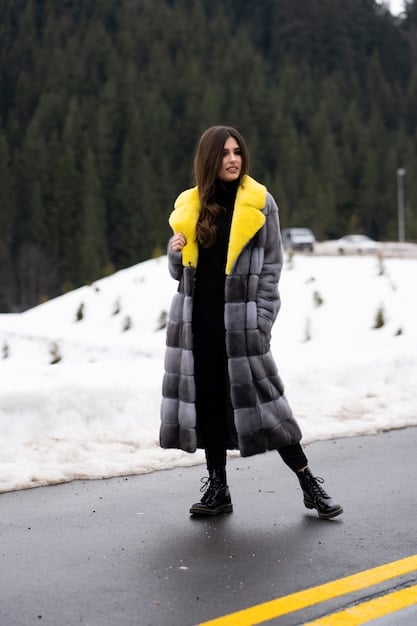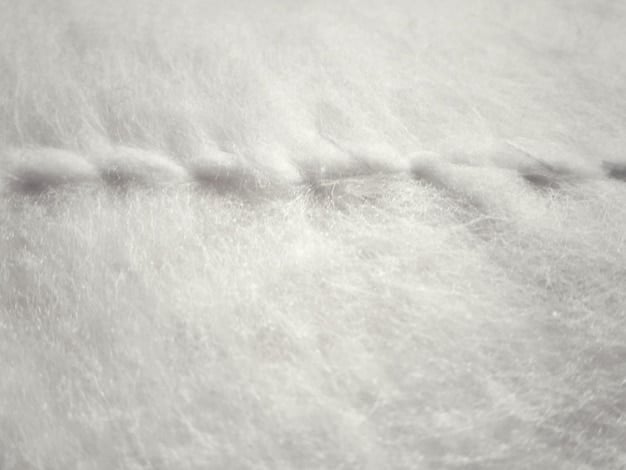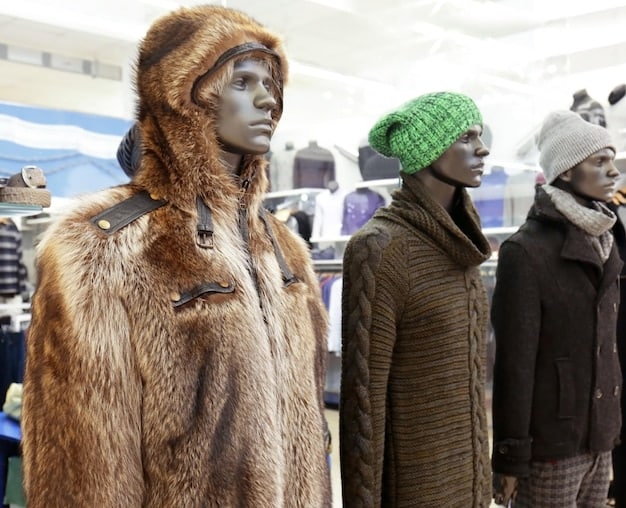Winter 2025: Stay Warm & Stylish in Sub-Freezing Temperatures

Winter 2025: The Ultimate Guide to Staying Warm and Stylish in Sub-Freezing Temperatures offers indispensable advice on selecting insulated outerwear, layering effectively, choosing winter-ready footwear, accessorizing smartly, and adapting your style to extreme cold for both comfort and fashion.
Navigating the frigid temperatures of winter 2025 requires more than just bundling up; it demands a strategic approach to staying warm and maintaining your personal style. This Winter 2025: The Ultimate Guide to Staying Warm and Stylish in Sub-Freezing Temperatures provides you with the essential knowledge and tips to not only survive but thrive in sub-freezing conditions, ensuring you remain both comfortable and fashionable throughout the season.
Understanding the Science of Staying Warm
Before diving into the latest trends, it’s crucial to understand how your body loses heat and how clothing can help mitigate this. Understanding the science behind staying warm allows you to make informed decisions when selecting your winter wardrobe.
How Your Body Loses Heat
Your body loses heat through several mechanisms, including conduction, convection, radiation, and evaporation. Conduction occurs when your body comes into direct contact with a colder surface, while convection involves heat loss through the movement of air or liquid. Radiation involves heat escaping in the form of infrared waves, and evaporation occurs when sweat turns into vapor.
The Role of Insulation
Insulation works by trapping air and reducing heat transfer. Materials like down, wool, and synthetic fibers create pockets of air that slow down the rate at which heat can escape, keeping you warmer for longer. The key is to choose materials that offer high insulation without being too bulky or heavy.

Here are some key factors to consider when selecting insulation:
- Type of Insulation: Down is excellent for dry, cold conditions, while synthetics are better for wet environments.
- Fill Power: For down, fill power indicates the quality and loft of the down; higher fill power means better insulation.
- Weight: Consider the weight of the insulation in relation to its warmth; lighter materials are often more comfortable for extended wear.
By understanding these principles, you can make smarter choices about your winter clothing, ensuring you stay warm and comfortable even in the most extreme conditions.
Selecting Insulated Outerwear
Your outerwear is your first line of defense against the cold, making it essential to choose wisely. Look for coats, jackets, and parkas designed to withstand sub-freezing temperatures, offering both insulation and protection from wind and moisture. Consider the specific features and materials that will best suit your needs.
Key Features to Look For
When shopping for insulated outerwear, pay attention to features like a waterproof and windproof outer shell, a well-insulated hood, adjustable cuffs, and secure closures. These details can significantly enhance your comfort and protection in harsh weather.
Top Material Choices
Popular choices for outerwear materials include:
- Gore-Tex: Known for its waterproof and breathable properties.
- Thinsulate: A lightweight synthetic insulation that provides excellent warmth.
- Wool: A natural fiber that offers warmth and moisture-wicking capabilities.
- Down: Provides exceptional warmth-to-weight ratio, ideal for very cold conditions.
Selecting the right combination of features and materials will ensure your outerwear keeps you warm, dry, and comfortable all winter long.

Mastering the Art of Layering
Layering is a fundamental strategy for staying warm in sub-freezing temperatures, allowing you to adjust your clothing to changing conditions. Understanding the principles of layering can greatly enhance your comfort and versatility.
The Base Layer
The base layer is the foundation of your layering system, designed to wick moisture away from your skin. Materials like merino wool and synthetic fabrics are excellent choices for this layer, helping to keep you dry and comfortable.
The Mid Layer
The mid layer provides insulation, trapping heat close to your body. Fleece, down, and synthetic fill are common materials for this layer, offering different levels of warmth and breathability.
The Outer Layer
The outer layer protects you from the elements, shielding you from wind, rain, and snow. A waterproof and windproof jacket or coat is essential for this layer, ensuring you stay dry and comfortable in harsh weather.
Here are some tips for effective layering:
- Start with a moisture-wicking base layer.
- Add an insulating mid layer.
- Finish with a protective outer layer.
Layering allows you to adapt to changing temperatures and activity levels, ensuring you stay comfortable throughout the day.
Winter-Ready Footwear: Keeping Your Feet Warm and Dry
Proper footwear is essential for keeping your feet warm and dry in sub-freezing temperatures. Look for boots designed with insulation, waterproof materials, and good traction to navigate icy and snowy conditions.
Insulation and Materials
Insulated boots with waterproof membranes, such as Gore-Tex, are ideal for winter wear. Materials like Thinsulate and wool provide excellent warmth, while durable rubber outsoles offer traction on slippery surfaces.
Traction and Grip
Look for boots with deep treads and specialized rubber compounds designed for winter conditions. These features will help you maintain stability and avoid slips and falls on ice and snow.
Accessorizing for Warmth and Style
Accessories are not only stylish additions to your winter wardrobe but also essential for staying warm in sub-freezing temperatures. Hats, scarves, gloves, and insulated socks can make a significant difference in your overall comfort.
Hats
A warm hat is crucial for preventing heat loss from your head. Look for hats made from wool, fleece, or other insulating materials. A hat that covers your ears is especially important in extreme cold.
Scarves
Scarves protect your neck and face from wind and cold. Choose scarves made from wool, cashmere, or fleece for maximum warmth. Wearing a scarf that can be wrapped around your face provides additional protection in extreme conditions.
Gloves
Gloves or mittens are essential for keeping your hands warm. Mittens tend to be warmer than gloves because they allow your fingers to share heat. Look for gloves or mittens with waterproof and windproof shells and insulated linings.
Socks
Insulated socks made from wool or synthetic materials can help keep your feet warm and dry. Avoid cotton socks, as they tend to retain moisture and can make your feet feel colder. Consider wearing liner socks to wick away moisture and prevent blisters.
Adapting Your Style to Extreme Cold
Staying warm in sub-freezing temperatures doesn’t mean sacrificing your personal style. With the right strategies and choices, you can adapt your wardrobe to extreme cold while still looking fashionable.
Incorporating Bold Colors and Patterns
Don’t be afraid to incorporate bold colors and patterns into your winter wardrobe. Brightly colored outerwear, scarves, and hats can add a pop of visual interest to your look, even on the gloomiest days.
Choosing Stylish and Functional Pieces
Look for pieces that combine style and functionality. Insulated coats with flattering silhouettes, waterproof boots with fashionable designs, and stylish hats and scarves can help you stay warm and look great.
Experimenting with Textures
Mixing different textures can add depth and visual interest to your winter outfits. Combine smooth leather or nylon with fuzzy knits and plush faux fur for a luxurious and cozy look.
Here are some additional tips:
- Opt for faux fur-trimmed hoods.
- Choose accessories in complementary colors.
- Add a statement belt to cinch your waist over bulky layers.
| Key Point | Brief Description |
|---|---|
| 🌡️ Understanding Heat Loss | Learn how your body loses heat to choose the right clothing. |
| 🧥 Insulated Outerwear | Select coats with waterproof shells and effective insulation. |
| 🧣 Accessorizing for Warmth | Use hats, scarves, and gloves to protect against the cold. |
| ❄️ Layering Effectively | Master the base, mid, and outer layers for adaptable warmth. |
Frequently Asked Questions
▼
Merino wool or synthetic fabrics are best for base layers as they wick moisture away from the skin, keeping you dry and warm. Avoid cotton, which retains moisture and can make you feel colder.
▼
Typically, three layers are recommended: a moisture-wicking base layer, an insulating mid-layer (like fleece or down), and a waterproof and windproof outer layer. Adjust the mid-layer based on the temperature and your activity level.
▼
Yes, mittens are generally warmer than gloves because they allow your fingers to share heat. However, gloves offer better dexterity if you need to perform tasks requiring fine motor skills.
▼
When choosing winter boots, wear the socks you plan to wear with them and ensure there’s enough room to wiggle your toes. A little extra space helps with insulation and blood circulation.
▼
Follow the care instructions on the garment’s label. Generally, down coats should be professionally cleaned, while synthetic coats can often be machine washed. Always ensure your coat is completely dry before storing it.
Conclusion
Staying warm and stylish in sub-freezing temperatures requires a thoughtful approach to your wardrobe choices. By understanding the principles of heat loss, selecting insulated outerwear, mastering the art of layering, choosing winter-ready footwear, accessorizing effectively, and adapting your style, you can confidently face the winter of 2025 with both comfort and flair.





